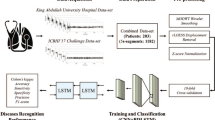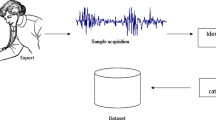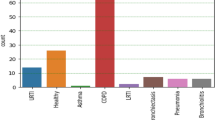Abstract
Artificial intelligence has been a revolutionary concept for the healthcare sector in recent years. Deep Neural Networks (DNNs) are subdomains of machine learning which is a vital tool for applications such as diagnostic and therapy suggestions. Pulmonary diseases significantly influence the overall well-being of numerous individuals worldwide, greatly hampering their ability to lead a healthy and balanced life. The present study uses an ensemble technique to detect Pulmonary Diseases. Here, lung sounds obtained by auscultation are transformed into spectrograms and classified using Convolutional Neural Networks (CNN) trained on various architectures. The proposed study shows an accuracy of 97.3%.
Access this chapter
Tax calculation will be finalised at checkout
Purchases are for personal use only
Similar content being viewed by others
References
Chronic obstructive pulmonary disease (COPD) (2022) https://www.who.int/news-room/fact-sheets/detail/chronic-obstructive-pulmonary-disease-(copd). Accessed 05 Dec 2022
Auscultation—an overview|ScienceDirect Topics. https://www.sciencedirect.com/topics/nursing-and-health-professions/auscultation. Accessed 09 Dec 2022
Fraiwan M, Fraiwan L, Khassawneh B, Ibnian A (2021) A dataset of lung sounds recorded from the chest wall using an electronic stethoscope. Data Brief 35:106913
Yu KH, Beam AL, Kohane IS (2018) Artificial intelligence in healthcare. Nat Biomed Eng 2(10):719–731
Harrison O (2019) Machine learning basics with the K-nearest neighbors algorithm. https://towardsdatascience.com/machine-learning-basics-with-the-k-nearest-neighbors-algorithm-6a6e71d01761. Accessed 09 Dec 2022
Palaniappan R, Sundaraj K, Ahamed NU (2013) Machine learning in lung sound analysis: a systematic review. Biocybern Biomed Eng 33(3):129–135
Aykanat M, KiliÇ Ö, Bahar K, Saryal SB (2020) Lung disease classification using machine learning algorithms. Int J Appl Math Electr Comput 8(4):125–132
Spectrogram—an overview|ScienceDirect Topics. https://www.sciencedirect.com/topics/engineering/spectrogram. Accessed 11 Dec 2022
Sze V, Chen YH, Yang TJ, Emer JS (2017) Efficient processing of deep neural networks: a tutorial and survey. Proc IEEE 105(12):2295–2329
Cerliani M (2020) Neural networks ensemble. https://towardsdatascience.com/neural-networks-ensemble-33f33bea7df3. Accessed 09 Dec 2022
Chen H, Yuan X, Pei Z, Li M, Li J (2019) Triple-classification of respiratory sounds using optimized s-transform and deep residual networks. IEEE Access 7:32845–32852
Dubey R, Bodade RM (2019) A review of classification techniques based on neural networks for pulmonary obstructive diseases. Proc Recent Adv Interdisc Trends Eng Appl (RAITEA)
Nussbaumer HJ (1981) The fast fourier transform. In: Fast fourier transform and convolution algorithms, pp 80–111. Springer
Moorer JA (2017) A note on the implementation of audio processing by short-term fourier transform. In: 2017 IEEE workshop on applications of signal processing to audio and acoustics (WASPAA). IEEE, pp 156–159
Bardou D, Zhang K, Ahmad SM (2018) Lung sounds classification using convolutional neural networks. Artif Intell Med 88:58–69
Tariq Z, Shah SK, Lee Y (2019) Lung disease classification using deep convolutional neural network. In: 2019 IEEE international conference on bioinformatics and biomedicine (BIBM). IEEE, pp 732–735
Bharati S, Podder P, Mondal MRH (2020) Hybrid deep learning for detecting lung diseases from x-ray images. Inf Med Unlocked 20:100391
Vgg16 architecture (2019) https://iq.opengenus.org/vgg16/. Accessed 11 Dec 2022
Simonyan K, Zisserman A (2014) Very deep convolutional networks for large-scale image recognition. arxiv:1409.1556
Team GL (2021) Introduction to VGG16|What is VGG16? https://www.mygreatlearning.com/blog/introduction-to-vgg16/. Accessed 11 Dec 2022
Szegedy C, Ioffe S, Vanhoucke V, Alemi A (2016)Inception-v4, inception-resnet and the impact of residual connections on learning. arxiv: 1602.07261
Tsang SH (2020) Review: inception-v4—evolved from GoogLeNet, merged with ResNet Idea (Image Classification). https://towardsdatascience.com/review-inception-v4-evolved-from-googlenet-merged-with-resnet-idea-image-classification-5e8c339d18bc. Accessed 11 Dec 2020
Brital A (2021) Inception V4 CNN architecture explained. https://medium.com/@AnasBrital98/inception-v4-cnn-architecture-explained-23a7fe12c727. Accessed 11 Dec 2022
He K, Zhang X, Ren S, Sun J (2015) Deep residual learning for image recognition. arxiv: abs/1512.03385
Understanding ResNet50 architecture (2020) https://iq.opengenus.org/resnet50-architecture/. Accessed 11 Dec 2022
Altan G, Kutlu Y, Gökçen A (2020) Chronic obstructive pulmonary disease severity analysis using deep learning onmulti-channel lung sounds. Turk J Electr Eng Comput Sci 28(5):2979–2996
Mo A, Gui E, Fletcher RR (2022) Use of voluntary cough sounds and deep learning for pulmonary disease screening in low-resource areas. In: 2022 IEEE global humanitarian technology conference (GHTC). IEEE, pp 242–249
Nathan V, Vatanparvar K, Chun KS, Kuang J (2022) Utilizing deep learning on limited mobile speech recordings for detection of obstructive pulmonary disease, pp 1338–1341
Srivastava A, Jain S, Miranda R, Patil S, Pandya S, Kotecha K (2021) Deep learning based respiratory sound analysis for detection of chronic obstructive pulmonary disease. PeerJ Comput Sci 7:e369
Maklin C (2019) Fast fourier transform. https://towardsdatascience.com/fast-fourier-transform-937926e591cb. Accessed 20 Dec 2022
Short-Time Fourier Transform—an overview|ScienceDirect Topics. https://www.sciencedirect.com/topics/engineering/short-time-fourier-transform. Accessed 20 Dec 2022
Koech KE (2021) Softmax activation function—how it actually works. https://towardsdatascience.com/softmax-activation-function-how-it-actually-works-d292d335bd78. Accessed 9 Dec 2022
Rocha B, Filos D, Mendes L, Vogiatzis I, Perantoni E, Kaimakamis E, Natsiavas P, Oliveira A, Jácome C, Marques A et al (2017) A respiratory sound database for the development of automated classification. In: International conference on biomedical and health informatics. Springer, pp 33–37
Author information
Authors and Affiliations
Corresponding author
Editor information
Editors and Affiliations
Rights and permissions
Copyright information
© 2023 The Author(s), under exclusive license to Springer Nature Singapore Pte Ltd.
About this paper
Cite this paper
Kulkarni, S. et al. (2023). ELPDI: A Novel Ensemble Learning Approach for Pulmonary Disease Identification. In: Pundir, A.K.S., Yadav, A., Das, S. (eds) Recent Trends in Communication and Intelligent Systems. ICRTCIS 2023. Algorithms for Intelligent Systems. Springer, Singapore. https://doi.org/10.1007/978-981-99-5792-7_4
Download citation
DOI: https://doi.org/10.1007/978-981-99-5792-7_4
Published:
Publisher Name: Springer, Singapore
Print ISBN: 978-981-99-5791-0
Online ISBN: 978-981-99-5792-7
eBook Packages: Intelligent Technologies and RoboticsIntelligent Technologies and Robotics (R0)




